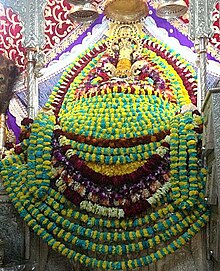Khatu Shyam
| Khatushyam | |
|---|---|

Idol of Khatu Shyam in Khatushyam temple shree shyam Reengus dham
|
|
| Other names | Maurvinandan, Sheesh Ke Daani |
In Hinduism, KhatuShyam is a name and manifestation of Barbarik, Grandson of Bhima and Son of Ghatotkach. This manifestation is especially popular in the Indian state of Rajasthan and Haryana. The original Sanskrit name Barbarīka is often replaced in Rajasthan by the Hindi version, Barbarīk, often written as Barbareek.
Barbarika had obtained a boon from Krishna to the effect that he would be known by Krishna's own name (Shyam) in the Kaliyuga era (presently ongoing) and worshiped. Krishna had declared that Barbarika's devotees would be blessed just by pronouncing his name from the bottom of their hearts. Their wishes would be granted and troubles removed if they worship Shyamji (Barbarika) with a true piety.
After the Mahābhārata battle, Barbarika's head was drowned in the river named Rupawati by Lord Krishna giving lots of blessings.After many years when Kalyug started the head was found buried in the village of Khatu (District- Sikar) in present-day Rajasthan. The location was obscured until well after the Kaliyuga period began. Then, on one occasion, milk started flowing spontaneously out of a cow's udder when she neared the burial spot. Amazed at this incident, the local villagers dug the place up and the buried head was revealed. The head was handed over to a Brahmin who worshipped it for many days, awaiting divine revelations as to what was to be done next. Roopsingh Chauhan, king of Khatu, then had a dream where he was inspired to build a temple and install the head therein. Subsequently, a temple was built and the idol was installed on the 11th day of the Shukla Paksha (bright half) of the month of Phagun.
There is another, only slightly different version of this legend. Roopsingh Chauhan was the ruler of Khatu. His wife, Narmada Kanwar, once had a dream in which the deity instructed her to take his image out of the earth. The indicated place (now known as Shyam Kund) when then dug up. Sure enough, it yielded the idol, which was duly enshrined in the temple.
...
Wikipedia
